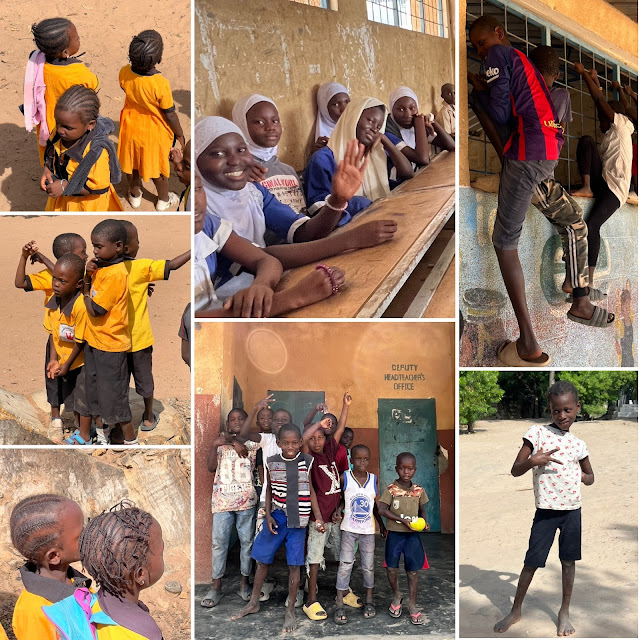West Africa Series: The Gambia
Title: A Journey Through Banjul: Exploring the Heart of The Smiling Coast
The Gambia, the smallest country in the Mainland Africa, carries a profound historical legacy. But as I embarked on my adventure to Banjul, the capital city of The Gambia, I decided to steer away from the well-trodden paths of history and dive into the soul of this vibrant land. Passing beneath the iconic Arch 22 in an open jeep, I caught just a glimpse of the historical monument setting the tone for an adventure focused on the soul of contemporary Gambia. .
Past the Arch 22, the landscape transformed into a patchwork quilt of contrasts. From humble dwellings to bustling markets - established stores and market stalls that stretched for miles. Banjul's essence lay in its rich tapestry of colors and diversity. The open jeep allowed us to immerse ourselves in the sights, sounds, and scents of this enchanting place. Approaching the local markets, the scenery exploded into a kaleidoscope of hues. Market stalls spilled over with fresh produce, handmade crafts, and a lively energy that permeated the air. The tapestry of fabrics worn by the marketgoers added yet another layer to the city's visual allure. Traditional garments adorned with bold patterns and radiant colors showcased the rich cultural heritage that Banjul proudly carries.
Leaving the bustling market behind, my journey unfolded along the coastal edges, weaving through the bush, revealing the enchanting tapestry of Gambian village life
One of the highlights was the Tanji Nature Trail, a living museum that showcased the rich diversity of Gambian cultures. The vibrant tapestry of traditions and customs painted a picture of a society deeply connected to its roots. Later, the expedition led me to encounters with nature's lively inhabitants – chattering monkeys swinging through their treetop and exotic birds, adding a kaleidoscope of colors to the landscape.
However, it was the encounters with local communities that left an indelible mark on my journey. At a random compound and school, the warmth of the people welcomed us, eager to share their stories and traditions. It was an immersive experience, bridging the gap between strangers and fostering a genuine connection.
A pivotal moment was our visit to a school where I had the opportunity to interact with enthusiastic school kids. The schoolchildren, their faces beaming with enthusiasm, sang tunes that resonated with the rhythm of Banjul. Outside, curious boys climbed windows, eager to catch a glimpse of the unfolding tourist spectacle. The teachers and principal showed us around, providing insights into the challenges they face. They showed us a modest library, filled with weathered books that stood in stark contrast to the technologically advanced libraries many of us are accustomed to. It was a poignant reminder of the varying landscapes of education around the world. While our children are equipped with laptops and digital resources, here, resilience and determination thrived amid limited resources.
The schoolchildren, captivated by the novelty of visitors, eagerly followed us around, their faces lighting up with curiosity and joy. Among them, a boy who seemed wise beyond his years, initially appearing to be around 10, but surprising me when he revealed he was 13. His impeccable English skills and articulate conversation revealed a glimpse into his aspirations.
The girls, adorned in well-groomed uniforms and braided hair, exuded a sense of pride and determination. Their poised demeanor suggested a commitment to education and a resilience that spoke volumes about the strength embedded in Banjul's community. Each photograph captured not just a moment frozen in time but a glimpse into the stories of these young minds shaping the future of their country.
Our journey continued to the fishing village. Our jeep rumbled along the bumpy and dusty road, every bump resonating through the jeep, creating a rhythmic dance with the uneven terrain. It was a photographable landscape, but I could no longer hold on to my camera, so I gave up taking pictures. But despite the heat and dizzying ride, excitement bubbled within as the promise of local food and beach awaited, offering a refreshing dip in its waters.
Arriving at the fishing village, the water’s allure was less than expected, yet the scene was a photographer’s delight. Men labored, hauling a fishing boat ashore, while a self-proclaimed tour guide tried to show me the day’s catch – a spectacle from crustaceans to fish. Women diligently cleaned the bounty, showcasing the vibrant rhythm of daily life. A lone girl in a red dress, balancing a basket of bananas atop her head caught my eyes. I asked her if I could take her picture and she willingly posed for me. I gave her some dollars $$ for the trouble, but she said, "What's this? I don't know this."
Leaving the village, I couldn't help but reflect on the essence of Banjul being the "smiling coast." It was not just the picturesque landscapes or the warm hospitality but the resilience and joy emanating from the people I encountered. In the simplicity of their lives, I found a profound source of happiness, reminding me that true wealth often lies in the human connections and shared moments that transcend time and technology.
The Gambia, the land of Kunta Kinte, unfolded a different story to me—one of vibrant cultures, harmonious coexistence with nature, and the enduring spirit of a community. As I left the "smiling coast," I carried with me not just memories of a journey but a deeper understanding of the beauty that lies in the simplicity of life.
PHOTO GALLERY
















Comments
Post a Comment